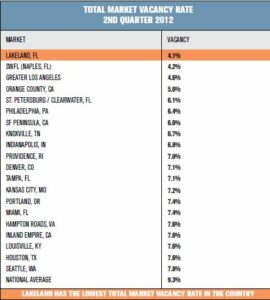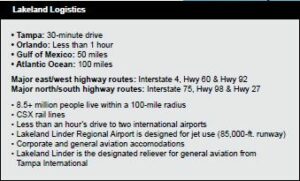Checking the pulse of the commercial market with the Lakeland Economic Development Council
The Lakeland Economic Development Council (LEDC) is a private, non-profit organization with over 140 member companies. The LEDC’s primary role is to help create jobs and capital investment by attracting new companies as well as facilitating the expansion of existing companies in Lakeland. We asked them a few questions about recent trends in our area.
The Lakelander: What are the metrics used to assess the health of local commercial real estate?
LEDC: Metrics used include vacancy rate, rental rates, and speculative construction/inventory development (this is land owner/developer building a facility without a tenant in tow), average annual square footage developed, average annual capital investment, average annual number of jobs, and average number of companies starting/locating in the city.
 TL: What trends are you seeing?
TL: What trends are you seeing?
LEDC: For example, square footage developed, capital investment, and number of jobs were signicantly higher in 2012 than in either 2010 or 2011. e 2012 year ended with een companies creating more than 1,092 jobs and $123 million in capital investments to the area.
TL: What type of company does LEDC want to attract to the area?
LEDC: Generally, companies that make sense for the area: those that will raise the average wage (we target 115 percent of average annual wage) and those that will create a clustering eect of services, infrastructure, and ancillary businesses. We want companies that will be engaged in the community, help others, bring others along. Everything starts with business
investment.
TL: What makes a community attractive to commercial real estate development?
LEDC: e old adage: location, location, location. Geographically, we are located in the center of the state, making it easy for companies to serve Florida and/or surrounding states. Moreover, there are more than 8.5 million people within a 100-mile radius of Lakeland. No other city in the Southeast can say this. We are less than an hour’s drive to two international airports. e City of Lakeland owns and runs all of its own utilities, it has infrastructure in place (water/wastewater, sewer), a low cost of doing business (millage rate, taxes), ease of doing business (permitting, regulatory agencies), and a politically friendly business climate.
TL: What does the Lakeland MSA (Metropolitan Statistical Area) do well with regard to attracting manufacturers?
LEDC: For a city its size, Lakeland has great infrastructure in place to serve manufacturers. Lakeland’s utilities have grown with Publix over the years to serve the needs of their food-based manufacturing. According to the Brookings Institute, the Lakeland MSA ranks No. 4 in the United States for manufacturing jobs as a percentage of all jobs (15.3 percent). We have 36,000 manufacturing jobs, which are mainly comprised of food, chemical, and fabricated metals. We were recently able to attract Brew Hub, a cra beer and
co-pack facility, to locate in Lakeland because of the advanced water utilities we had in place.

TL: What needs to improve?
LEDC: Removing barriers to entry or the ease with which to do business into our community could improve. It’s our goal and hope that anyone wanting to start a business, large or small, could do so. Processes for starting a new business should be easy to understand and navigate.
TL: How does a healthy commercial real-estate stock benefit the area?
LEDC: It benefits the area by attracting the ancillary business and services in companies’ ecosystems and by generating tax revenue. For example, manufacturers tend to be extremely value added because they will use all city services, paying impacts and taxes, tangible taxes, and other companies will move here or expand to serve them. They establish roots; they won’t just move tomorrow, and a lot of innovation comes from them. We have some of the lowest vacancy rates in the nation, which can be a blessing and a curse, so a mitigation of impact fees for spec development is offered by the city. We want to have available buildings because the area will be more attractive to companies. It’s one thing to say we can build to suit and another to say we have available space.
 TL: How does the LEDC facilitate the process?
TL: How does the LEDC facilitate the process?
LEDC: The LEDC identifies the scope of the project: expansion or new industry, type of industry, projected new jobs, do they have their financing in place, what size building and/or site are needed, what transportation or labor needs do they have, etc. We make them aware of any state and local incentives they may be eligible for and the process/timing involved. If land and/or a building are needed, we work with prospects to make sure they have seen all of the available spaces/sites meeting their projects’ requirements. This looks like us setting up site tours with the broker/owner to tour property. We offer anonymity for the prospect, meaning they could have interaction with several property owners, city officials, and more, without having to reveal who they are. If permitting and regulatory agencies are involved, we set up pre-meetings with the city, county, and other necessary parties to make sure the key departments that will interface with the project can advise them before plans are submitted, to expedite the process. The LEDC is there to be a connector/liaison throughout the entire project, being involved as little or as much as needed. Our goal is to keep the existing companies happy and healthy, and convert new industry into community partners that establish deep roots in our community.
1989-2012
AVG. ANNUAL SQ. FT.: 1,184,180
AVG. ANNUAL CAPITAL INVESTMENT: $48,347,965
AVG. ANNUAL # OF JOBS: 1,018
AVG. # OF COMPANIES PER YEAR: 23

